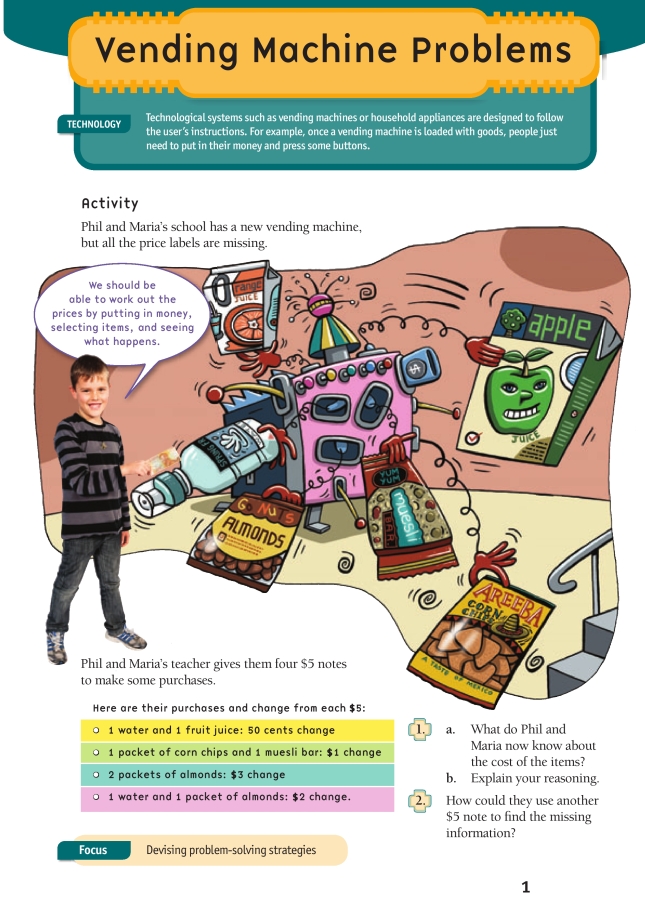This is a level 3 activity from the Figure It Out series.
A PDF of the student activity is included.
Click on the image to enlarge it. Click again to close. Download PDF (379 KB)
Deductive reasoning is the process of using logic to solve problems. A simple way to start solving a problem is to write down what you know and what you need to find out. The simple act of writing out the combined cost of each pair of items (rather than the change that the machine gives) can help the students to identify the price of one item, which can then be used to find the price of other items. They can also use trial and error.
This activity involves choosing and using a strategy to solve a problem.
The following steps are useful when problem solving:
- understand and explore the problem
- find a strategy
- use the strategy to solve the problem
- look back and reflect on the solution.
Explore the problem-solving strategies on www.nzmaths.co.nz, for example, guess, act it out, draw, make a list, think, be systematic, keep track, look for patterns, and work backwards. Discuss with the students which strategies would be most useful for this problem.
Maria and Phil needed to make 5 purchases to find the cost of the 5 items. They used information from 4 purchases to find the cost of 4 items. Ask the students to investigate how many purchases are needed to find the cost of 1, 2, or 3 items. Is it possible to find the cost of 4 items using just 3 purchases? (The answer is no. The minimum number of purchases needed to solve problems of this nature will always equal the number of unknown costs.)
You could extend this investigation by asking students to design their own vending machine problems. Creating solvable problems can prove more difficult than actually solving them. The challenge is to provide enough clues for a solution to be found but not so many that the problem becomes too easy.
Technology-related student activities
- Gather lists or pictures of vending machines or machines that operate with money or cards. This would include parking machines, gate barriers, and so on.
- Brainstorm the problems facing machine designers. For example, designers would need to make sure fake coins would not work or that only one product was dispensed at a time.
Note: Do not expect your students to explain how devices work but just to be aware of what they do. The concept of the black box within a technological system is an important one. (See www.techlink.org.nz/curriculum-support/strategies/tk-systems/level3.htm) - List other examples of technological systems in which people give initial instructions or input and the rest is done by a machine. An example would be dialling a telephone number.
- Consider who would be happy with the introduction of a particular machine (for example, one that dispensed very sugary lollies) and who may not be so pleased.
Exploring the technology-related context
Many modern technologies have their origin in antiquity, including the first vending machine. With industrialisation in the late nineteenth century, vending machines started to become familiar in western cities. New Zealand’s Robert Dickie, credited with inventing the stamp vending machine, is an example of a lateral thinker and designer who produced effective solutions to technological problems. (See www.nzedge.com/heroes/dickie.html)
Today, there are many varieties of vending machines, dispensing a wide range of products.
Designers must consider a number of factors in order to produce economical, reliable, safe, and tamper-proof machines. Vending machines are a good example of how technological innovation must cater for a range of human needs, fallibilities, and societal constraints.
Answers to activity
1. a. Phil and Maria’s information can be used to work out these prices:
- water: $2.00
- fruit juice: $2.50
- almonds: $1.00.
b. Strategies will vary. Trial and error will work, but the most efficient way to get a solution is to first find the cost of the almonds. 2 packets of almonds gives $3 change. This means that the 2 packets cost $2 ($5 – $3 = $2), so each packet must be $1. This information can be used to find the cost of the water (water + almonds = $3). The cost of the water can be used to find the cost of the fruit juice. (You can’t find out the cost of corn chips or a muesli bar because neither of these items is matched with a known price.)
2. Answers may vary. One option is for them to buy 2 packets of corn chips so that they can work out the cost of a single packet. Once they know the price of the corn chips, they can work out the cost of the muesli bar using the results of an earlier purchase (1 packet of corn chips and 1 muesli bar costs $4).
